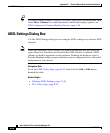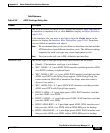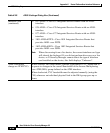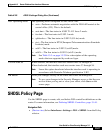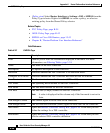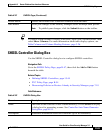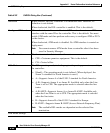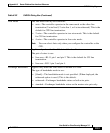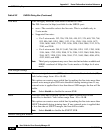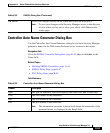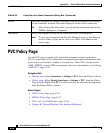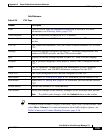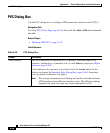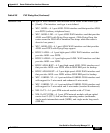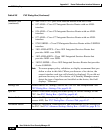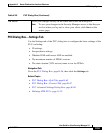
Appendix K Router Platform User Interface Reference
SHDSL Policy Page
K-52
User Guide for Cisco Security Manager 3.2
OL-16066-01
Line Rate Does not apply when the Line Mode is defined as Auto.
The DSL line rate (in kbps) available for the SHDSL port:
• auto—The controller selects the line rate. This is available only in
2-wire mode.
• Supported line rates:
–
For 2-wire mode: 192, 256, 320, 384, 448, 512, 576, 640, 704, 768,
832, 896, 960, 1024, 1088, 1152, 1216, 1280, 1344, 1408, 1472,
1536, 1600, 1664, 1728, 1792, 1856, 1920, 1984, 2048, 2112, 2176,
2240, and 2304.
–
For 4-wire mode: 384, 512, 640, 768, 896, 1024, 1152, 1280, 1408,
1536, 1664, 1792, 1920, 2048, 2176, 2304, 2432, 2560, 2688, 2816,
2944, 3072, 3200, 3328, 3456, 3584, 3712, 3840, 3968, 4096, 4224,
4352, 4480, and 4608.
Note Third-party equipment may use a line rate that includes an additional
SHDSL overhead of 8 kbps for 2-wire mode or 16 kbps for 4-wire
mode.
SNR Margin settings
Current The current signal-to-noise (SNR) ratio on the controller, in decibels (dB).
Valid values range from -10 to 10 dB.
This option can create a more stable line by making the line train more than
current noise margin plus SNR ratio threshold during training time. If any
external noise is applied that is less than the set SNR margin, the line will be
stable.
Note Select disable to disable the current SNR.
Snext The Self Near-End Crosstalk (SNEXT) signal-to-noise ratio on the
controller, in decibels. Valid values range from -10 to 10 dB.
This option can create a more stable line by making the line train more than
SNEXT threshold during training time. If any external noise is applied that
is less than the set SNEXT margin, the line will be stable.
Note Select disable to disable the SNEXT SNR.
SHDSL dialog box buttons
Table K-22 SHDSL Dialog Box (Continued)



